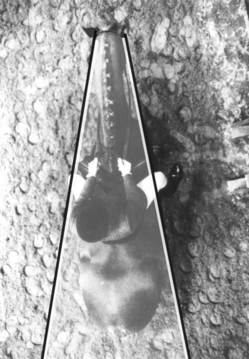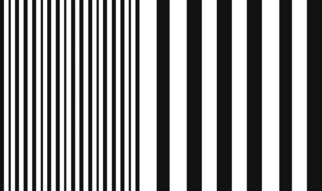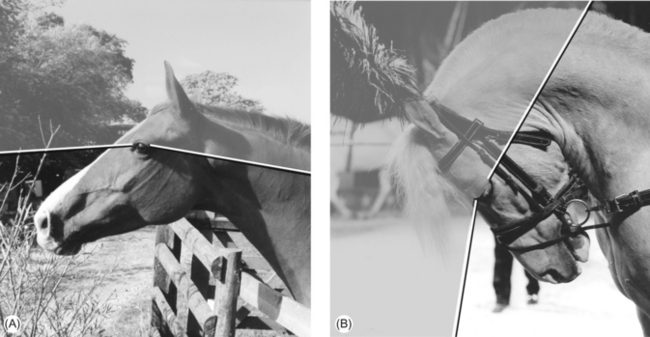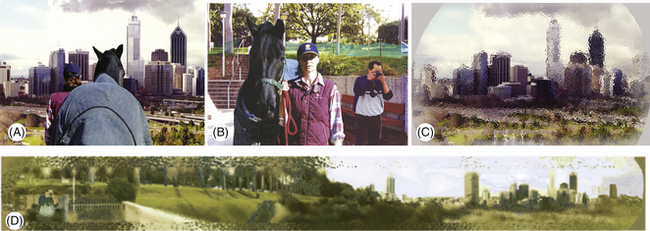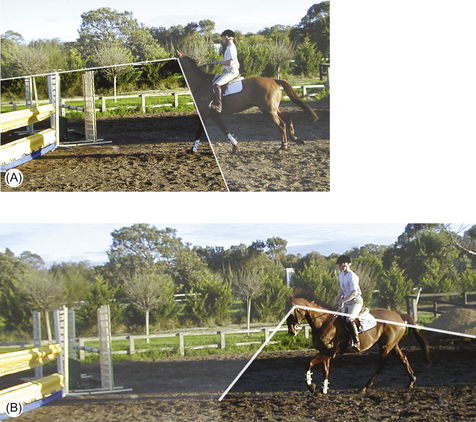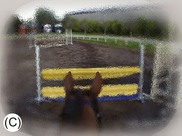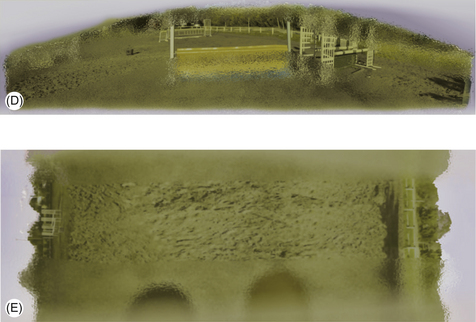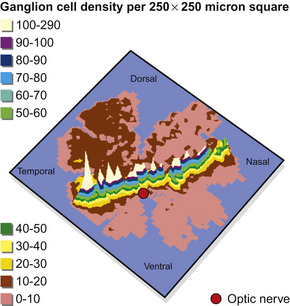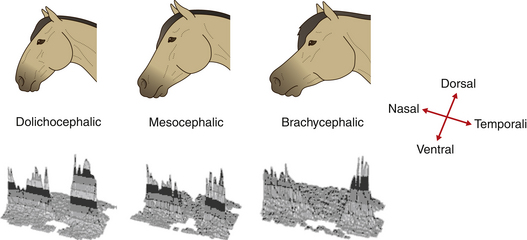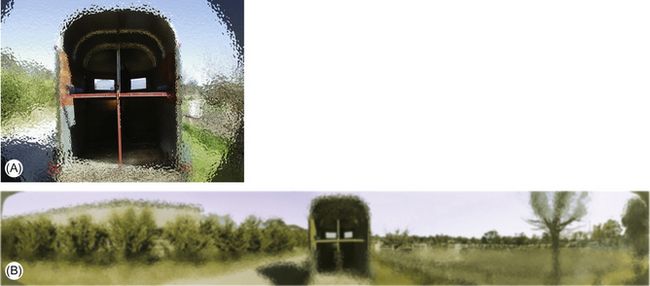Chapter 2 Perception
Chapter contents
Horses have been described as being among the most perceptive of animals.1 By studying the sensory perception of horses, we gain valuable insights into their behavior, but we should also be reminded of the care we must take to be consistent in the subtleties of our body language when handling and training them. The differences between human and equine perceptions of the external environment can be explained, in part at least, by the differences in their sensory structures. The horse’s adept perception has allowed it to be constantly aware of changes occurring in its surroundings and this has played a pivotal role in the success of the species. An appreciation and understanding of the horse’s well-developed sensory system are valuable tools, particularly when attempting to understand distinctive aspects of equine behavior.
Vision
The equine eye is among the largest, and held by some to be the largest, in terms of absolute dimensions, of any terrestrial mammal.2,3 Leaving aside the aesthetic appeal of this, it suggests that the horse relies heavily on visual information about its environment. With large retinae and a relative image magnification that is 50% greater than that of humans,4 the horse’s eyes allow it to visualize a wide panorama of the horizon and also the area ahead where feet will be placed and fodder will be selected. As a herbivorous flight animal, the horse has good distance vision, allowing it to scan widely for danger and, despite being relatively poor at accommodation, with a vertical field of 178°,4 it is able to visualize the ground immediately ahead while grazing.
Horse eyes occupy a lateral position on the head, affording a panoramic view in front and on both sides, with only a narrow blind area to the rear (Fig. 2.1). The narrow blind zone at the back of the horse of approximately 20° for each eye,5 can be unveiled by a slight turn of the head. For example, when kicking with its hindlegs, a horse may turn its head to ensure that its target is no longer in the blind area. The width of the blind zone is determined by the level at which the head is carried. As most practitioners appreciate, the blind zone can be effectively increased by cupping one hand around the lateral canthus, an intervention which pacifies many horses that have learned to anticipate aversive stimuli as part of veterinary intervention (see Ch. 14).5
The price horses pay for having laterally placed eyes is that the muzzle gets in the way of forward vision. Depending on the carriage of the head, the particular breed and the setting of the eyes, there is a blind zone extending almost 2 m directly in front of the horse. When the head is down the horse’s binocular field is located down the nose in the direction of grass. Therefore horses can see where they eat especially well. This is why, if they do want to see directly in front rather than down the nose, horses have to lift up the nose and point it at the object of interest.
The exposition of more sclera is often noted in anxious animals (Fig. 2.2) because the eyes are opened wider to take in more visual information that may help them resolve the situation, while a fixed eye may be associated with reasonably chronic distress. It is widely believed that the extent of oscillation of eye movements and the amount of sclera shown can be helpful in assessing the disposition of horses,6 but, if the horse has a relatively small iris, that may detract from the reliability of this effect.
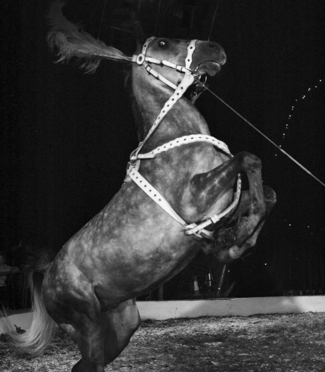
Figure 2.2 Rearing horse showing the white of its eye.
(Reproduced with permission of the Captive Animals Protection Society.)
Acuity
There are a number of aspects of vision that can be measured. Visual acuity describes the ability to distinguish the fine details of an object. Clearly, the nearer an object is to the eye, the finer the detail that can be distinguished. Horses’ eyes are geared to be focused largely on more distant features and, like those of many mammal species, appear to have limited accommodation, i.e. the ability to focus on very close objects less than about 1 m away. Animals that have been trained to discriminate between panels painted gray and those bearing black and white stripes can expose their species’ acuity. As panels with ever finer stripes are presented to the observer, the discrimination task becomes more difficult (Fig. 2.3). The point at which the lines blur together and appear to be gray (the limit of acuity) is marked by a failure to discriminate. Most birds that have been tested excel at this task. They can distinguish extremely narrow stripes that occupy as little as  th of a degree of their visual field. Horses can perceive stripes that fill about
th of a degree of their visual field. Horses can perceive stripes that fill about  th of a degree.
th of a degree.
An interesting way of expressing the horse’s acuity is in comparison with normal human vision, as 20/33. This indicates that a horse can only discern at 20 m what a human can at 33 m,7 and this compares favorably with the dog (20/50) and the cat (20/100).7 Horses’ eyes are extremely sensitive to movement in all areas of their visual field, but human peripheral vision is considered a good approximation of the visual detail horses can appreciate.8
The visual field is affected by the corpora nigra, which are found on the upper margin of the pupillary aperture, possibly as an anti-glare device.9 The corpora nigra contain an intricate network of blood vessels, which suggests that they might also be used to oxygenate the anterior chamber of the eye (Alison Harman, personal communication 2002). For horses to see through their narrow pupils, they adjust their head position up and down or side to side. Best frontal vision of the ground in front is achieved when the horse flexes slightly at the poll. Horses commonly hold their heads in this position when they are moving in slower gaits. This was thought to improve focus and enhance images of the ground ahead.6 However, when over-flexed so that the nose is behind the vertical, the horse cannot see the space in front of it and so, when being ridden, may occasionally collide with objects, people and other horses if not directed (Fig. 2.4).
A functionally important blind spot is created when a horse is ridden with its nasal planum behind the vertical. The blind spot is formed to the front of the horse, and is believed to be as wide as the body. Thus, when a horse is being ridden in such a fashion it cannot see directly in front of itself. Hyperflexed horses are said to be showing signs of submission and ‘listening to their riders’, but it is possible that compromising a horse in this way makes it more reliant on the rider to avoid obstacles and such that it seems more biddable. Before using physical constraints, such as tie-downs and standing martingales to keep the head down or overchecks to keep it up, one should consider the effect of these restraints on the horse’s ability to convey itself safely over rough terrain and most especially over jumps. The effect on vision is subject to current debate since Bartos et al10 drew attention to the ability of the horse to rotate its eyeball to maintain the pupil in a horizontal position. These authors claimed that the horse maintains the ‘horizontal eyeball position regardless of head position’, suggesting that this rotation overcomes any deficit in vision that might otherwise arise from the horse having its nose pointed caudally by the rider. However, they did not report the head positions they examined, and their photos seemed to imply that the nose was always somewhat in front of the vertical. They were not concerned with forward binocular vision and did not use any technique such as ophthalmoscopy to determine visual field11 or alignment of the pupil relative to the corpora nigra, so it is difficult to comment on their findings. Some recent data counter the generalization that pupil rotation can overcome all changes in head position, indicating that in extreme head positions the pupil is not parallel to the ground12, but further work is needed to confirm this.
The horse has mostly monocular vision, i.e. each eye sees a completely different field of view. However, horses have a small binocular field at the front of the monocular fields. Therefore, the horse can adjust its view to overlap the visual fields of both eyes and achieve a binocular view (Fig. 2.5). This binocular field of view allows the horse to observe the ground in front with both eyes.
To see objects at a greater distance, the horse rotates its nose upwards because its binocular overlap is oriented down the nose (Fig. 2.6). It is believed that when focusing on objects to the fore, horses may momentarily lose the ability to observe from the rear and to the sides.7 That said, when taking off for a jump, horses sometimes tilt their head sideways, using their lateral vision to get a better look at jumps as they get up close. Perhaps this is why blinkers have found little favor in show-jumping circles, the traditional source of a multiplicity of gadgets. Blinkers are most effective in preventing shying and have been favored by carriage drivers because they make horses less likely to attempt to turn in the shafts or bolt. It is also suggested that blinkers can render a horse more responsive to voice commands used to increase speed because they prevent it from seeing when the driver is neither carrying nor about to use a whip (Les Holmes, personal communication 2002). Blinkers on racing animals bring rather different benefits – especially, it seems, when used for the first time. It has been suggested that, if it is a generally low-ranking animal, a racehorse that sees another horse approaching from behind is more likely to defer to the challenger if not wearing blinkers. This assumes that more high-ranking horses are more motivated to take the lead in a galloping herd, a hypothesis that has yet to be tested.
It has been shown that the horse’s eye has a visual streak (Fig. 2.7). This linear retinal region contains high concentrations of ganglion cells, while low concentrations appear in the peripheral regions. Concentrations in the visual streak reach 6100 cells/mm2, with the peripheral regions ranging between 150 and 200 cells/mm2.11 It is worth noting that the distribution of ganglion cells within the visual streak of horses depends on skull shape. Long-skulled (dolichocephalic) breeds, such as the Standardbred, have less centralization of their ganglion cells than the short-skulled (brachycephalic breeds), such as the Arabian, and are therefore thought to have better peripheral vision13 (Fig. 2.8).
Depth perception
It was long believed that animals with laterally placed eyes and extensive monocular visual fields did not have stereopsis – the ability to see in stereo and perceive depth. However, studies14 have demonstrated that the horse’s binocular field is an arc of approximately 60° in front of the head, affording good stereopsis and thresholds of depth detection comparable to those of cats and pigeons. These findings indicate that larger interocular distances, as found in the horse, may provide useful depth judgment. This may have arisen because the horse has evolved to make judgments over a range of several meters, whereas ground-feeding birds, such as pigeons, with an extremely small interocular distance, have to focus at a distance of only a few centimeters. Horses also use monocular depth cues to judge distance.4 This makes sense because they spend so much of their day with their heads to the ground, a position that makes stereopsis redundant.
Harman et al11 suggest that when a horse lifts its head the binocular area of vision is directed at the horizon, enabling scanning and depth perception. In this position monocular lateral vision is compromised. However, when the head is lowered and the binocular vision is directed at the area directly in front of the head, the lateral monocular fields afford good lateral horizon vision.
Effective use of the binocular field is required when a horse attempts to discern an object that is close and low. The horse is best able to use its binocular field of view by arching the neck and rotating the head. It can focus on the object by simultaneous rotation of the eye downward to optimize orientation of the visual streak (see p. 37).
Stimulus visibility
Factors that affect the visibility of a stimulus for a horse include size of the object, contrast and environmental illumination. When a moving horse spots something underfoot, it not only looks at the stimulus, but is also likely to change speed.15 The level of arousal plays a part in the recognition of stimuli, an outcome that may be influenced by the horse’s age and training because recognition of distant stimuli on the ground is facilitated by carrying the head at a lower angle. Saslow15 found that younger animals tend to carry their heads higher and therefore may not notice stimuli as readily as older horses, especially those that have been trained not to carry their neck straight and head high.
Saslow15 also found that horses were able to discern stimuli better in overcast rather than bright sunny conditions. This suggests that the equine rod-dominated eye may not find bright conditions as favorable as dull conditions. That said, naïve horses are often reluctant to make the transition from a well-illuminated area into relative darkness. This is part of the challenge that trailers (floats in the USA) represent. The high proportion of rods to cones (generally 20:1)16 gives the horse excellent night vision but insufficient to make them innately fearless of areas that are poorly lit. As we will see in Chapter 4, horses will work to keep a stable illuminated, and this further explains the aversiveness of small dark spaces, including trailers (Fig. 2.9). A reflective layer of cells behind the retina, the tapetum, enhances vision in poor light. Acting like a mirror, the tapetum reflects light back on to the retina, enabling further light to be gathered. The downside of this arrangement is that image quality is somewhat compromised. Because several receptors may be stimulated by incoming light, acuity can be reduced and the image becomes fuzzy. This effect has been likened to the pixelation of a low-resolution digital image.4
Accommodation
Horses have a small degree of ciliary accommodation,17 which relies on the contraction of ciliary muscles and contractile fibers that extend into the corpora nigra. However, despite weak lens muscles, horses’ optics allow them to see, on the whole, between about 1 m away and infinity, with little need to vary the lens. Accommodation is required if there is a need to see even closer than that with high acuity. Horses rarely need to do that; indeed because the eye’s proximity to objects is generally limited by the length of the nose,18 things very close are felt via the skin and vibrissae of the muzzle, so highly focused vision is not essential.
According to what was originally referred to as the ‘ramp retina’ theory, it was believed that the distance from the nodal point of the eye to the retina varied so that the dorsal retina was farther away than the more central and ventral regions. This theory was supported by the observation that horses are likely to exhibit characteristic head-moving behavior when looking at things. For example, the head may be raised unusually high and the nose pointed forward when observing an object of interest to the fore. The horse may arch its neck sideways (cock its head) to look at an object of unusual interest beside it (Fig. 2.10).
Stay updated, free articles. Join our Telegram channel

Full access? Get Clinical Tree


